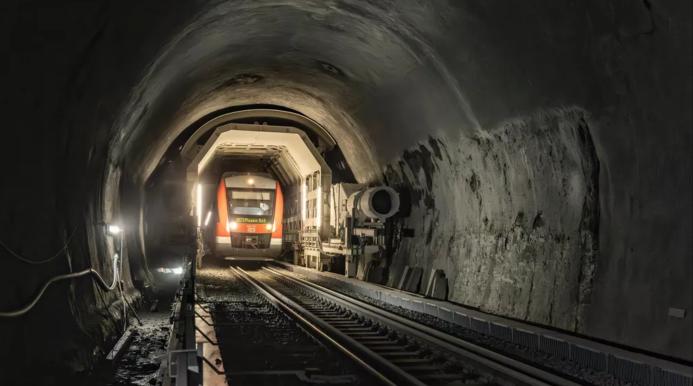Tunnels enlarged while trains continue running
Germany’s Herrenknecht, best known for its tunnel boring machines, has developed a new system that allows railway tunnels to be enlarged while keeping trains in operation.
The Tunnel Enlargement System (TES) has been in use since January 2024 to renew two 160-year-old Deutsche Bahn tunnels near Limburg an der Lahn, Germany.
The Fachingen Tunnel (426m) and Cramberg Tunnel (732m), both part of the Lahn Valley Railway connecting Koblenz and Wetzlar, are undergoing upgrades. Built in the 19th century, they need enlarging to meet modern standards, including electrification, accommodating larger track sizes, and allowing faster trains.
Herrenknecht’s TES makes it possible to carry out this work without interrupting rail services. The process involves dismantling the old tracks and laying a temporary track in the middle of the tunnel. Rail traffic continues to run on this track while the TES moves forward step by step. The machine not only widens the tunnel but also acts as a protective barrier, separating construction work from the operational railway.
The TES machines used for these tunnels are 46m-long, weigh 270 tonnes, and have a diameter of 12m. They run on specially laid foundations and rails within the tunnel.

The process involves breaking out the old tunnel walls, excavating rock using chiselling or blasting, and removing the debris with conveyor systems. Temporary support is then applied, including shotcrete, reinforcement mesh, and steel arches, before the final tunnel lining is completed in a second phase using in-situ concrete.
The TES consists of three sections: the front protects against tunnel collapse during excavation, the middle houses the equipment used for tunnelling, and the rear includes the systems that operate the machine, such as hydraulics, compressors, and material storage.
The current project in Germany builds on previous experience with the TES, which was first used in Spain. In March 2024, the system completed the enlargement of the Gaintxurizketa Tunnel, which connects the Spanish and French rail networks in the Basque Pyrenees, improving links as part of the EU's Atlantic corridor.
The current project for Deutsche Bahn is being carried out by a consortium including Porr, Feldhaus Bergbau, and Heinz Schnorpfeil Bau.








